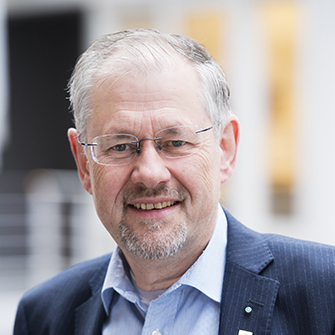"I arrive to a stage which is already set ... to a school with amazing co-workers"
Interview with the new Head of School
By the communication department at EECS
Head of School Jens Zander wants the school with the proposed name “Electrical Engineering and Computer Science (EECS)” to be part of the international top layer that brings KTH to the top 20 technical universities in the world. With a solid career starting with a radio amateur certificate Jens Zander, who has been named mobile guru and IT authority, has a strong vision for “EECS”.
– The nicknames were due to my group's close collaboration with Ericsson, where our research contributed to all the influential EU projects that led to 3G, 4G and now 5G. And the 20 and some doctoral students who graduated from my group has contributed to Ericsson's research and development over the years and thereby left substantial marks on the Swedish mobile industry. We have not always been in agreement with Ericsson, which of course the media has been eager to cover. The fact that we have been "right" in most cases does not make matters worse.
Studies in Engineering Physics and Electrical Engineering
Jens's fascination with electronics arose when he studied Engineering Physics and Electrical Engineering at Linköping University. Immediately after his Master of Science studies he continued to doctoral studies. Spin-off company SECTRA was founded in 1984 where he, together with friends and some of his professors, did consultancy work and developed products in security and communications. Only five years later, the Swedish mobile pioneers saw the need for a chair in Radio Communication Systems at KTH. Jens applied and was offered the position.
– When you are 33 years old and get the chance to get an endowed chair at KTH, it’s an offer you can’t refuse. Starting a new professorship was very similar to SECTRA's entrepreneurial work - great freedom to make decisions, but nothing is to be taken for granted and you have to do the most of the work yourself.
With an industrial donation of SEK 5 million in 1989, this became a starting point for KTH's forthcoming major investments in Kista. The telecom industry had established itself there already, but not academia. It became a great challenge for Jens. The money was available, but the corridors were empty. Fast forward to today and the starting point for the creation of the new school “EECS” is completely different.
– The differences are of course enormous; here I arrive to a stage which is already set. I arrive to a school with amazing co-workers and with a well-established collaboration with industry and society. We will be the largest school at KTH. Within several of the EECS subject areas, we rank among the top 50 universities in the world. The challenge I foresee is how we can interact even better and become even stronger, especially in the field of education.
Influenced by Clayton Christiansen's "Innovative University"
When looking through the media archives, Jens Zander is described as a visionary in the field of IT. For example, in 2003 he predicted that Ericsson would probably go from an electronics company to a system solution provider and now here we are. For “EECS” he has the following vision:
– I'm influenced by Clayton Christiansen's" Innovative University ", which paints a future where universities are divided into an ”A Team” and a ”B Team”. The A Team is the top ranked university that attracts the best students, the best teachers and most of the resources. The B Team is depleted of resources and is dedicated to teaching through MOOCs (created by the A Team). For me it is obvious that KTH belongs to the international A Team of maybe 100-150 universities or top 20 in the field of technology. It's a tough challenge and we're not there in all areas yet.
Collegiality, respect and transparency
But the school, that will be KTH's largest, has its challenges. Jens’s key words are collegiality, respect, predictability and transparency. He believes that it is important for a knowledge organization such as KTH to pay great respect to the vast competence within their respective areas that all employees possess.
– It becomes natural that responsibility lies and decisions are made where the competence is. Therefore the new "institutions" where the subject expertise exists will be given clear and transparent ground rules which provide great opportunities to design their future both in terms of faculty and subject content in the courses, but the education activities also require central management. Particularly our broad education programs for Bachelor and Master of Science in Engineering span a number of subjects and can therefore not be handled at an "institution" focused on one subject. Hence it is important that those programs are managed at a school level.
As the largest school at KTH, "EECS" will also have KTH's largest administration, a service organization that spans two campuses and a number of buildings. At the same time, the entire KTH University Administration will be reviewed.
– Our challenge is to provide a uniform and efficient support for teachers, researchers and students while preserving the local relations. To me it is natural that "EECS" as the largest school also takes a leading role in the administrative transformation of KTH.

